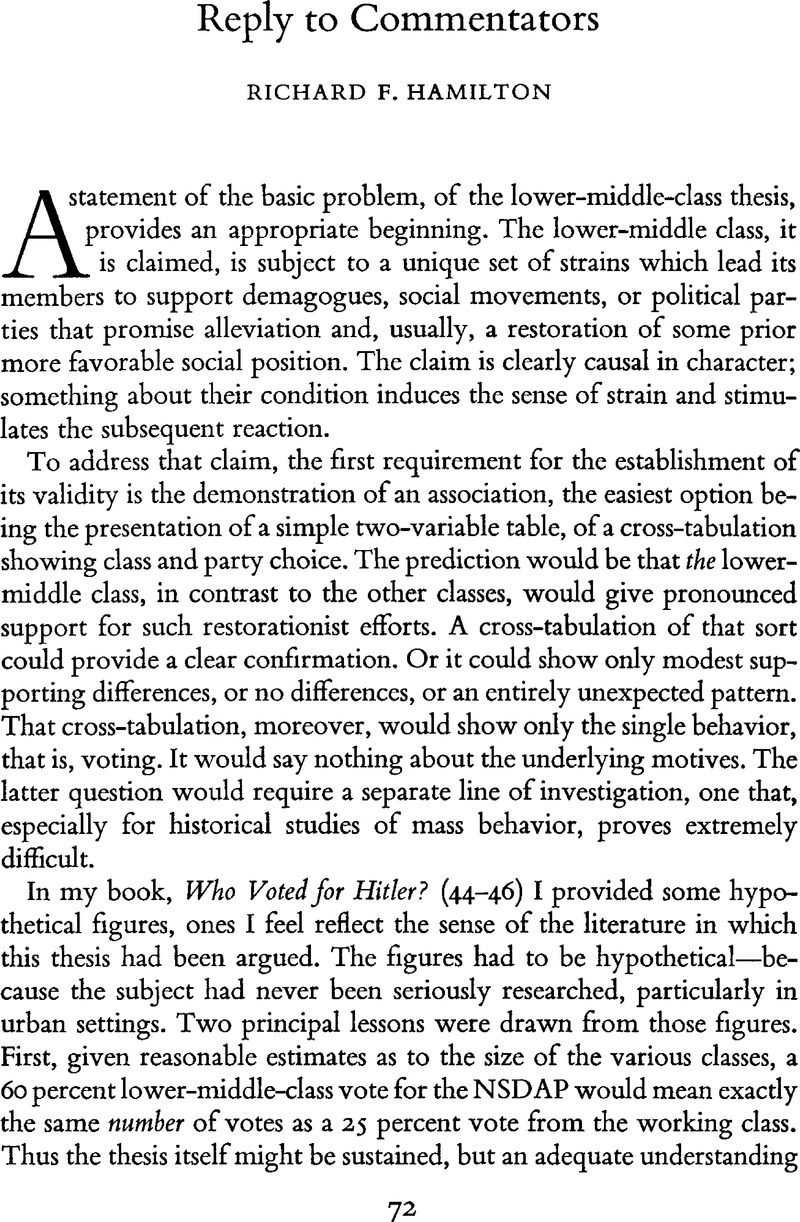No CrossRef data available.
Article contents
Reply to Commentators
Published online by Cambridge University Press: 16 December 2008
Abstract

- Type
- Symposium: Who Voted for Hitler?
- Information
- Copyright
- Copyright © Conference Group for Central European History of the American Historical Association 1984
References
1. Childers's book, The Nazi Voter, contains a series of statistical errors, the most important of which is multicollinearity. These throw into question his entire multivariate analysis. Falter concludes, in a forthcoming review, that the analysis must be redone before one can accept any of the statistical conclusions. The problem is signaled by the unlikely and difficult-to-interpret finding that National Socialist votes increased with the percentage of Protestants and with the percentage of Catholics.
Childers cites the work of Michael Kater as supporting his position on the “lower-middle-class” question. But that work also shifts away from the causal question to the compositional one. For a discussion, see my comments in the American Historical Review 89, no. 2 (April 1984): 469–70.
2. The reference is to Berelson, Bernard R., Lazarsfeld, Paul F., and McPhee, William N., Voting: A Study of Opinion Formation in a Presidential Campaign (Chicago, 1954).Google Scholar
3. A systematic content analysis of National Socialist literature from the 1930 election was undertaken by Hackett, David Andrew, “The Nazi Party in the Reichstag Election of 1930,” unpublished Ph.D. dissertation, Madison, Wisconsin, 1971.Google Scholar His tabulation of themes (p. 285) gives a rather different picture of the propaganda emphases. The leading themes were: “Volk, 83; deutsch, 75; SPD, 74; Beamte, 56; Arbeiter, 50; Young Plan, 49; Zentrum/BVP, 45<; Juden, 37; Lüge, 37; KPD, 16; bürgerlich, 16; Mittelstand, 15.” Four of the 28 leaflets were addressed to workers, two to civil servants, these yielding the prominent references to Beamte and Arbeiter. The “bulk” of the references, however, are not easily subsumed under the occupational headings.
4. The text here comments on the organizational-influence hypothesis. Some researchers and commentators, it will be noted, take these same organizational pronouncements as clues to “underlying” member sentiment. They are, in effect, using those statements as one would a public opinion poll. This procedure has a serious flaw: it assumes internal democracy, that the organization's pronouncements will closely “reflect” member sentiments, this without the least effort to establish the point. For a case study of nonrepresentative voluntary associations, see my Restraining Myths, chap. 7, “Small Business Organizations: Malfunctioning Pluralism” (New York, 1975). The influence versus reflection hypotheses that, with good reason, arise in discussions of the mass media, have their counterpart in the analysis of voluntary associations although they, clearly, do not gain the same attention in this context. The linkages are simply assumed.
5. In discussions with people, I find a persistent tendency to “explain” newspaper choices in terms of some (usually unspecified) “structural characteristics” of the city in question. It is a difficult problem. Was there something exceptional about the “structures” of Cologne and Frankfurt that gave rise to the Kölnische Zeitung and the Frankfurter Zeitung? This argument, like the “reflection” argument, assumes the editorial decision-makers to be helpless prisoners of events. Another possibility, the one I have argued, is that a newspaper, over the years, can train its readers, can give tham a distinctive outlook. It is, essentially, an argument of a long-term media effect. One might keep these opposite possibilities in mind; they too might be explored in the course of that work in the newspaper archives.




